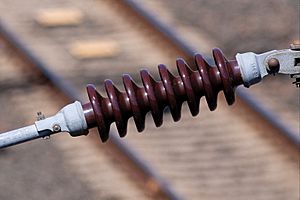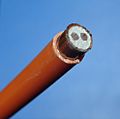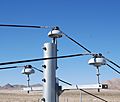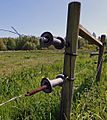Insulator (electricity) facts for kids
An electrical insulator is a material that does not easily allow flow of electricity through an electric current. Materials typically used to insulate include rubber, plastic and glass. In transformers and electric motors, varnish is used. Insulating gases such as Sulfur hexafluoride are used in some switches. Wires that carry electric currents are usually insulated so the electricity goes to the right place.
Insulator can mean not only the material but things that are made of that material. They are made of various materials such as: glass, silicone, rubber, plastic, oil, wood, dry cotton, quartz, ceramic, etc.
The type of insulator will depend on the uses. Insulators have high electrical resistivity and low conductivity. The insulators prevent the loss of current and make the current more efficient by concentrating the flow.
Insulator devices
Electric power transmission uses three types of overhead insulator: pin insulator, suspension insulator, and strain insulator.
- The pin insulator is the earliest developed insulator. Pin type insulators can have up to three parts, depending on the amount of voltage.
- The suspension insulator is for voltages above 33KV. Multiple insulators are connected in series.
- The strain insulator is the same as a suspension insulator but it is used horizontally, whereas the suspension insulator is used vertically. The strain insulator is used to relieve the line of excessive tension, which happens when there is dead end of the line or sharp curve.
Images for kids
-
Power lines supported by ceramic pin-type insulators in California, USA
-
High voltage ceramic bushing during manufacture, before glazing (1977)
-
Open-wire telegraph pole with porcelain insulators in Quidenham, Norfolk, United Kingdom
See also
 In Spanish: Aislamiento eléctrico para niños
In Spanish: Aislamiento eléctrico para niños














